红楼梦》唯一正确的英文译名
《红楼梦》两英译本死亡委婉语翻译的文化比较
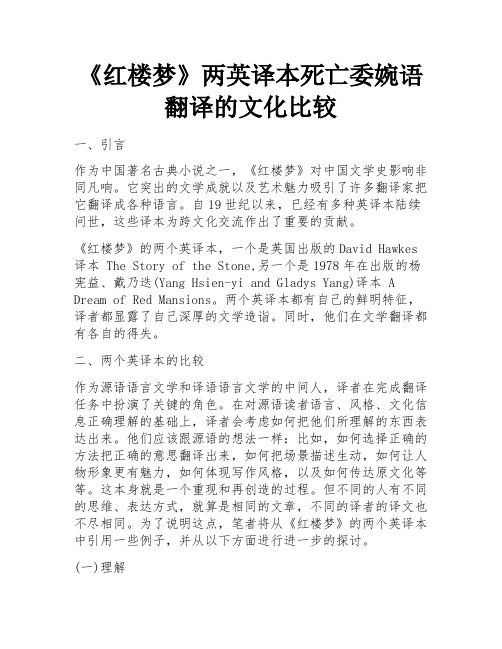
《红楼梦》两英译本死亡委婉语翻译的文化比较一、引言作为中国著名古典小说之一,《红楼梦》对中国文学史影响非同凡响。
它突出的文学成就以及艺术魅力吸引了许多翻译家把它翻译成各种语言。
自19世纪以来,已经有多种英译本陆续问世,这些译本为跨文化交流作出了重要的贡献。
《红楼梦》的两个英译本,一个是英国出版的David Hawkes 译本 The Story of the Stone,另一个是1978年在出版的杨宪益、戴乃迭(Yang Hsien-yi and Gladys Yang)译本 A Dream of Red Mansions。
两个英译本都有自己的鲜明特征,译者都显露了自己深厚的文学造诣。
同时,他们在文学翻译都有各自的得失。
二、两个英译本的比较作为源语语言文学和译语语言文学的中间人,译者在完成翻译任务中扮演了关键的角色。
在对源语读者语言、风格、文化信息正确理解的基础上,译者会考虑如何把他们所理解的东西表达出来。
他们应该跟源语的想法一样:比如,如何选择正确的方法把正确的意思翻译出来,如何把场景描述生动,如何让人物形象更有魅力,如何体现写作风格,以及如何传达原文化等等。
这本身就是一个重现和再创造的过程。
但不同的人有不同的思维、表达方式,就算是相同的文章,不同的译者的译文也不尽相同。
为了说明这点,笔者将从《红楼梦》的两个英译本中引用一些例子,并从以下方面进行进一步的探讨。
(一)理解理解原文是整个翻译过程的第一步。
这是至关重要的一步。
理解是翻译的基础,否则翻译将是空中楼阁。
大多数翻译错误都是由译者的误解造成的。
没有正确的理解,译者传达的就不是原文的意思。
其实任何对原意的改动都是对原著的不忠诚。
抛弃了原有观点的翻译,已经不是那个翻译了。
对汉语的理解包括对词意和句子的理解以及背景知识的理解。
《红楼梦》是一部“封建社会的百科全书”,这个社会的一切特点诸如等级制度,伦理道德等都渗透在字里行间。
汉语与英语是两种差距很大的语言,很多习惯说法不好懂,这也增加了翻译的困难。
中国古典四大名著英文
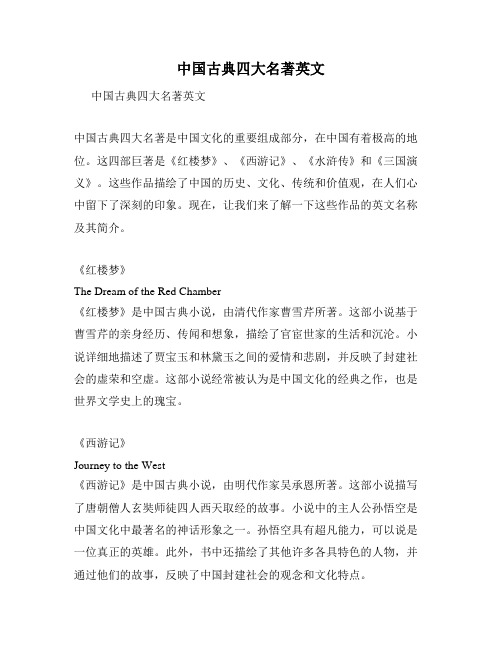
中国古典四大名著英文中国古典四大名著英文中国古典四大名著是中国文化的重要组成部分,在中国有着极高的地位。
这四部巨著是《红楼梦》、《西游记》、《水浒传》和《三国演义》。
这些作品描绘了中国的历史、文化、传统和价值观,在人们心中留下了深刻的印象。
现在,让我们来了解一下这些作品的英文名称及其简介。
《红楼梦》The Dream of the Red Chamber《红楼梦》是中国古典小说,由清代作家曹雪芹所著。
这部小说基于曹雪芹的亲身经历、传闻和想象,描绘了官宦世家的生活和沉沦。
小说详细地描述了贾宝玉和林黛玉之间的爱情和悲剧,并反映了封建社会的虚荣和空虚。
这部小说经常被认为是中国文化的经典之作,也是世界文学史上的瑰宝。
《西游记》Journey to the West《西游记》是中国古典小说,由明代作家吴承恩所著。
这部小说描写了唐朝僧人玄奘师徒四人西天取经的故事。
小说中的主人公孙悟空是中国文化中最著名的神话形象之一。
孙悟空具有超凡能力,可以说是一位真正的英雄。
此外,书中还描绘了其他许多各具特色的人物,并通过他们的故事,反映了中国封建社会的观念和文化特点。
《水浒传》The Water Margin《水浒传》是中国古典小说,由明代作家施耐庵所著。
小说讲述了开封府八十万禁军中的英雄好汉刘备、关羽、张飞等人的传奇故事。
这些英雄好汉都因被迫而作恶,最后通过奋斗和牺牲,成为了社会的正义力量。
这部丰富多彩的小说描绘了中国乡村和城市社会的生活和文化,反映了封建社会的封建主义和封建道德。
《三国演义》Romance of the Three Kingdoms《三国演义》是中国古典小说,由明代作家罗贯中所著。
这部小说讲述了从东汉末年到西晋建立期间的战争故事。
小说中的主要人物是曹操、刘备和孙权等人,他们在艰难的战斗中遭受了许多挫折。
故事表达了忠诚、勇气和智慧的重要性,也反映了中国封建社会的政治、社会和文化生活。
总结中国古典四大名著是世界文学史上的重要巨著。
红楼梦各个版本翻译对比
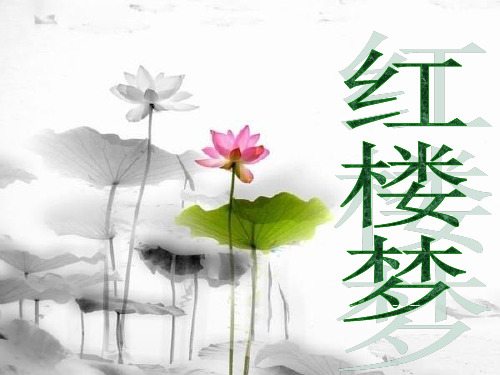
• 贾琏 Jia Lian 的妻子被称为Mrs. Lian 不但不 会感到别扭 ,而且会感到顺理成章。这也为将贾 宝玉译成 Master Bao ,将薛宝钗译成 Miss Bao 或 Miss Chai 提供了依据。特别值得一提的是宝 钗的译法:Miss Bao 。将薛宝钗译成Miss Chai 不 失为一种可能。据笔者的分析 ,最后在大部分 场 合译成Miss Bao ,一是为了同Master Bao 形成对 照 ,帮助读者记忆 ,另一个原因是为了影射宝玉与 宝钗的悲剧结合 ,后来两人成婚后 ,正好一个 Master Bao ,一个Mrs Bao ,有点命里注定的寓意。 这样一来 ,主人这方面的三个辈份便通过姓名的翻 译 ,分得清清楚楚。
王熙凤因笑道:“……竟不像老祖宗的外孙女儿,竟 是个嫡亲的孙女,”(第三回)
She doesn’t take after her father, son-in-law of our Old Ancestress, but looks more like a Jia.(杨氏)
She doesn’t take after your side of the family, Grannie, she’s more like a Jar. (霍氏) 由于英语中没有外孙女和孙女的区别,更没有亲疏之 别。在翻译该句时,霍氏采取意译,表现王熙凤奉承 老祖宗,但没有译出隐含的家族亲疏关系。杨氏直译 ,表现了句子的文化内涵。
(4)颦颦 Pin-pin (knitted brows 颦眉,这是宝玉送给黛玉 的表字)
(5)李纨 Li Wan (plain silk 素绢)
(6)官裁 Kung-tsai (palaces seamstress 宫殿女裁缝送白骨,今宵红灯帐底卧鸳鸯。(第一回) 杨译:Yesterday, yellow clay received white bones; Today, red lanterns light the love-birds’ nest. 霍译:Yesterday her lord's bones laid in clay; On silken
名著英译名称

名著英译名称名著英译名称《红楼梦》 A Dream of Red Mansions《⽔浒传》Outlaws of the Marsh《三国演义》The Romance of the Three Kingdoms 《西游记》Journey to the West 《儒林外史》The Scholars《聊斋志异》Strange T ales From a Lonely Studio 《西厢记》The West Chamber 《醒世恒⾔》Stories to A waken Men《喻世明⾔》Stories to Enlighten Men《警世通⾔》Stories to Warn Men《官场现形记》Exposure of the Official World《本草纲⽬》Outline of Hurb Medicine《史记》Historial Records《资治通鉴》History as a Mirror《⼭海经》The Classic of Mountains and Rivers 《论语》The Analects of Confucius 《⼤学》The Great Learning《中庸》The Doctrine of the Mean《孟⼦》The Mencius《诗经》The Book of Odes《世说新语》Essays and Criticism《封神演义》The Legend of delification《春秋》Spring and Autumn Annals《梁祝》The Butterfly Lovers《⽩蛇传》Madam White Snake《⾦瓶梅》The Golden Lotus《围城》 A Surrouded City《雷⾬》Thunderstorm《阿q正传》The True Story of Ah Q外国名著名称翻译1. The Red and The Black (by Stendhal) 红与⿊2. Jane Eyre (by Charlotte Bronte) 简爱3. How to make steel (by Nicola Ostrovsky) 钢铁是怎样炼成的4. Three Days to See (by Helen Keller) 假如给我三天光明5. Pride and Prejudice (by Jane Austen) 傲慢与偏见6. Wuthering Heights (by Emily Bronte) 呼啸⼭庄7. The Hunckback of Notre Dame (by Victor Hugo) 巴黎圣母院8. The Miserable World (by Victor Hugo) 悲惨世界9. Uncle Tom's Cabin (by H. Beecher Stowe) 汤姆叔叔的⼩屋10. The Diary of Anne Frank (by Anne Frank) 安妮⽇记11. Robinson Crusoe (by Daniel Defoe) 鲁滨逊漂流记12. Gulliver's Travels (by Jonathan Swift) 格利佛游记13. The Adventures of Alice in Wonderland (by Lewis Carrol) 艾丽斯漫游记14. Monte Cristo (by Alexandre Dumas) 基督⼭伯爵15. Gone with the Wind (by Margaret Mitchell) 飘16. Pygmalion (by Bernald Shaw) 茶花⼥17. The Case-Book of Sherlock Holmes (by Conan Doyle) 福尔摩斯探案全集18. The merchant of Venice (by Shakespeare) 威尼斯商⼈19. Celebrity biography (by Romain Rolland ) 名⼈传20. The Records about Insects (by Jean-Henri Casimir Fabre)昆⾍记21. Tales from the Arabian Nights (adapted by Michael West)天⽅夜谭22. Anderson's Fairy Tales安徒⽣童话集23. Grimm's Fairy Tales格林童话集24. Aesop's Fables 伊索寓⾔25. The Adventures of Huckleberry Fin (by Mark Twain) 哈克贝⾥芬历险记26. The Adventures of Tom Sawyer (by Mark Twain) 汤姆.索亚历险记27. The Old Man and The Sea (by Ernest Hemingway) ⽼⼈与海28. The Metamorphosis (by Franz Kafka) 变形记29. Treasure Island (by R. L. Steveson) ⾦银岛30. Oliver Twist (by Charles Dickens) 雾都孤⼉31. Sense and Sensibility (by Jane Austen) 理智与情感32. The Scarlet Letter (by Nathaniel Hawthorne) 红字33. Anna Karenina (by Leo Tolstoy) 安娜·卡列尼娜34. War and Peace (by Leo Tolstoy) 战争与和平35. Resurrection(by Leo Tolstoy) 复活36. A Tale of Two Cities (by Charles Dickens) 双城记37. The Thorn Birds (by Colleen Mccullough) 荆棘鸟38. The God Father (by Mario Puzo) 教⽗39. The Great Gatsby (by F. Scott Fitzgerald) 了不起的盖茨⽐40. Around the World in Eighty Days (by Jules Verne) 环绕世界⼋⼗天41. Hatter's Castle (by A. J. Cronin) 帽商的城堡42. The Gadfly (by E. L. Voynich) ⽜虻43. The Life of Abraham Lincoln (by Stegan Lorant) 林肯传44. The Story of Madame Curie ( by Alice Thorne) 居⾥夫⼈传45. Stories from Shakespeare (adapted by H. G. Wyatt) 莎⼠⽐亚戏剧故事集46. Les Confessions (by Rousseau) 忏悔录47. Carmen (by Merimee) 卡门48. Twenty Thousand Leagues Under the sea (by Jules Verne) 海底两万⾥49. Old Goriot (by Honoré de Balzac) ⾼⽼头50. Eugénie Grandet (by Honoré de Balzac) 欧也妮·葛朗台51. The call of the Wild (by Jack London) 野性的呼唤52. Great Expectations (by Charles Dickens) 远⼤前程53. David Copperfield (by Charles Dickens) ⼤卫·科波菲尔54. Little Woman (by Louisa May Alcott) ⼩妇⼈55. Walden (by Henry David Thoreau) ⽡尔登湖56. The short stories of Ohenry (by William Sydney Porter) 欧亨利短篇⼩说集57. Frankenstein (by Mary Shelley) 弗兰肯斯坦58. Woman in White (by Wilkie Collins) ⽩⾐⼥⼈59. Childhood/My Apprenticeship/My Universities (by Maksim Gorky)童年/在⼈间/我的⼤学60. One hundred years of solitude (by Garcia Marcos) 百年孤独61. Dead Souls (by Nikolai Vasilevich Gogol) 死魂灵62. Emma (by Jane Austen) 爱玛63. Joan of Arc (by George Bernard Shaw) 圣⼥贞德64. The Short Stories of Allan Poe(by Allan Poe)爱伦坡短篇⼩说集65. Mansfield Park (by Jane Austen) 曼斯菲尔德庄园66. Fathers and Sons (by Turgenev) ⽗与⼦67. The Sorrows of Young Werther (by Goethe) 少年维特之烦恼68. Faust (by Goethe) 浮⼠德69. Turandot (by Puccini Giacomao) 图兰朵70. If Tomorrow comes (by Sidney Sheldon) 假如明天来临71. The other side of midnight (by Sidney Sheldon) 午夜的另⼀⾯72. Rage of angels (by Sidney Sheldon) 愤怒的天使73. The Three Musketeers (by Alexandre Dumas) 三个⽕枪⼿74. Sister Carrie (by Theodore Dreiser) 嘉丽妹妹75. The story of the Bible (by Hendrik Willem van Loon) 圣经的故事76. Divine Comedy (by Dante Alighieri) 神曲77. Vanity Fair (by W. M. Thackeray) 名利场78. The American Tragedy (by Theodore Dreiser) 美国的悲剧79. The Decameron (by Giovanni Boccaccio) ⼗⽇谈80. Red Star over China (by Edgar Snow) 西⾏漫记81. Selected Readings from D. H. Lawrence 劳伦斯作品选读82. Sons and Lovers (by D. H. Lawrence) ⼉⼦和情⼈83. King Solomon's Mines (by H.Rider Haggard) 所罗门王的宝藏84. The Mill on the Floss (by George Eliot) 弗洛斯河上的磨坊85. The Prince and the Pauper (by Mark Twain) 王⼦和贫⼉86. The Scapegoat (by Daphne Du Maurier) 替罪⽺87. Far from the Madding Crowd (by Thomas Hardy) 远离尘嚣88. Frenchman's Creek (by Charles Dickens) 法国⼈的⼩港湾89. Wives and Daughters (by Elizabeth Gaskell) 妻⼦与⼥⼉90. Jaws (by Peter Benchley) ⼤⽩鲨91. The Final Diagnosis (by Arthur Hailey) 最后的诊断92. An Invisible Man (by H. G. Wells) 隐⾝⼈93. The Ragged Trousered Philanthropists (by Robert Tressell) 穿破裤⼦的慈善家94. The Rise and Fall of the Third Reich (by William L. Shirer) 第三帝国的兴亡95. Winds of War (by Herman Woul) 战争风云96. Grapes of Wrath (by J. Steinbeck) 愤怒的葡萄97. The Moneychangers (by Arthur Hailey) 钱商98. The Return to the Native (by Thomas Hardy) 还乡99. Frontiers of Science 科学的新领域100. Thirty-nine Steps (by John Buchan) 三⼗九级台阶101. Compell's Kingdom (by Hammond Innes) 坎伯尔王国102. Tom Brown's Schooldays (by Thomas Hughes) 汤姆·布朗的求学时代103. The Sign of Indra 印达拉神像。
四大名著的英语翻译题
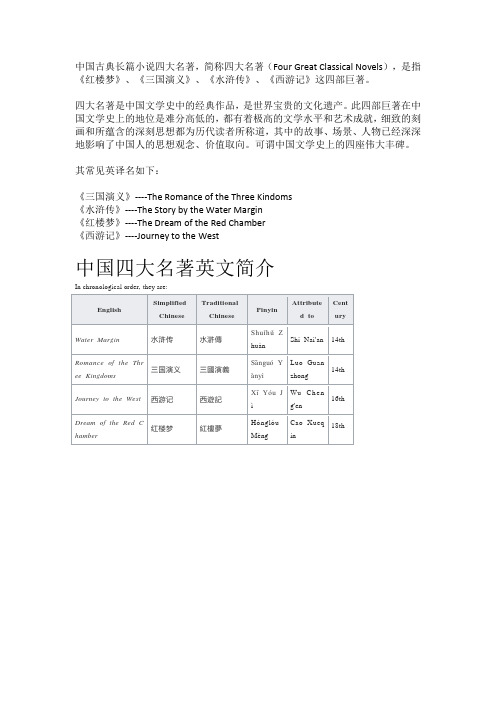
中国古典长篇小说四大名著,简称四大名著(Four Great Classical Novels),是指《红楼梦》、《三国演义》、《水浒传》、《西游记》这四部巨著。
四大名著是中国文学史中的经典作品,是世界宝贵的文化遗产。
此四部巨著在中国文学史上的地位是难分高低的,都有着极高的文学水平和艺术成就,细致的刻画和所蕴含的深刻思想都为历代读者所称道,其中的故事、场景、人物已经深深地影响了中国人的思想观念、价值取向。
可谓中国文学史上的四座伟大丰碑。
其常见英译名如下:《三国演义》----The Romance of the Three Kindoms《水浒传》----The Story by the Water Margin《红楼梦》----The Dream of the Red Chamber《西游记》----Journey to the West中国四大名著英文简介红楼梦 The Dream of the Red ChamberDream of the Red Chamber, also called The Story of the Stone, composed by Cao Xueqin, is one ofChina's Four Great Classical Novels. It was written sometime in the middle of the 18th century duringthe Qing Dynasty. Long considered a masterpiece of Chinese literature, the novel is generallyacknowledged to be the pinnacle of Chinese fiction. "Redology" is the field of study devoted exclusively tothis work.The title has also been translated as Red Chamber Dream and A Dream of Red Mansions. The novelcirculated in manuscript copies with various titles until its print publication, in 1791. Gao E, who preparedthe first and second printed editions with his partner Cheng Weiyuan in 1791–2, added 40 additionalchapters to complete the novel.Red Chamber is believed to be semi-autobiographical, mirroring the rise and decline of author CaoXueqin's own family and, by extension, of the Qing Dynasty. As the author details in the first chapter, it isintended to be a memorial to the damsels he knew in his youth: friends, relatives and servants. The novel isremarkable not only for its huge cast of characters and psychological scope, but also for its precise anddetailed observation of the life and social structures typical of 18th-century Chinese society.Also called "The story of the Stone (Shitouji 石头记)", this novel written by Cao Xueqin 曹雪芹(d. 1763) is said to be the greatest masterpiece of Chinese fiction. A wide branched scholarship does not consent about the main theme of this novel, should it be a novel of sentiment, of Daoist-Buddhist enlightenment, of social observation, of the decay of an aristocratic familiy, or even a veiled attack on Manchu rule. The frame of the novel is the contest of a Buddhist and a Daoist priest who make be born a young noble boy called Jia Baoyu 贾宝玉and his girl cousin Lin Daiyu 林黛玉.With a loving detail describing the life of the two cousins in a huge noble mansion, between gardens and palaces, the red thread is the triangular love between Baoyu, Daiyu and a second girl cousin called Xue Baochai 薛宝钗that is of more plumper character than the ever sick Daiyu. Switching between their life, the divine world and dreams, Baoyu becomes deranged after the disappearance of a stone (the origin of the second title) he had in his mouth when he was born. Not knowing, his love Daiyu died, he is tricked to marrying Baochai. Becoming aware of being tricked, Baoyu leaves the world of the "red dust" and becomes a monk. With hundreds of persons and their stories, paralleling the life and feelings of servants to the life of the main persons, the story is very complex and full of symbolisms, but very interesting and convincing for its encyclopedic character, depicting the life of a noble familiy in the 18th century Q ing China.三国演义Romance of The Three KingdomsRomance of the Three Kingdoms is a 14th-century historical novel attributed to Luo Guanzhong. It is setin the turbulent years towards the end of the Han dynasty and the Three Kingdoms period in Chinesehistory, starting in 169 AD and ending with the reunification of the land in 280.The story – part historical, part legend, and part mythical – romanticises and dramatises the lives of feudallords and their retainers, who tried to replace the dwindling Han dynasty or restore it. While the novelfollows hundreds of characters, the focus is mainly on the three power blocs that emerged from theremnants of the Han dynasty, and would eventually form the three states of Cao Wei, Shu Han, and EasternWu. The novel deals with the plots, personal and military battles, intrigues, and struggles of these states toachieve dominance for almost 100 years.Romance of the Three Kingdoms is acclaimed as one of the Four Great Classical Novels of Chineseliterature; it has a total of 800,000 words and nearly a thousand dramatic characters (mostly historical) in120 chapters. The novel is among the most beloved works of literature in East Asia, and its literaryinfluence in the region has been compared to that of the works of Shakespeare on English literature. It isarguably the most widely read historical novel in late imperial and modern China.Romance of The Three Kingdoms is one of the great chinese classics and is compiled into a semi-fictional literary masterpiece during the Ming Dynasty by Luo Guanzhong. The novel comprises around 70+% fact and 20+% fiction. Some issues such as Guan Yu's weapon weighing around 40+ kilograms, the capabilties of Lu Bu, Liu Bei's horses as well as the existence of the Hill of the Fallen Phoenix and some others are probably fictional.That period in history can be said as the golden age of chivalry and although it happened more than 1700 years ago, characters such as Liu Bei, Cao Cao, Guan Yu, Zhang Fei and Zhuge Liang have become household names among the chinese. Tales of their exploits, courage, adventures and many more are told in the novel "Romance of The Three Kingdoms".It is one of the most turbulent periods in China's history taking place toward the end of the Han Dynast y where corruption is rampant in the imperial court due to eunuches holding power. Coupled with natural disasters such as floods, plague and locust swarms devouring the crops grown by the peasants, hunger and disatisfaction among the peasants soon escalated rapidly until a major rebellion known as the "Yellow Scarves Rebellion" led by Zhang Jiao broke out. (It was dubbed "Yellow Scarves" because the rebels tied a yellow scarf on their head). Initially just a small band of rebels, dueto widespread hunger and ill-sentiment among the populace, swarms of common folks joined in the rebellion across many parts of the country.三国演义人物介绍刘备Liu Bei (161–223 AD), styled Xuándé (玄徳), was a general, warlord, and later the founding emperor of Shu Han during the Three Kingdoms era of China. Although having a later start than his rivals, also lacking both the material resources and social status they commanded, Liu Bei overcame his many defeats to carve out his own realm, that at its peak spanned modern day Sichuan, Guizhou, Hunan, part of Hubei, and part of Gansu.Culturally, due to the tremendously popular novel Romance of the Three Kingdoms by Luo Guanzhong, Liu Bei is widely known as the ideal benevolent, humane ruler who cared for his people and picked good advisors. His character was to advocate the Confucian set of moral values, such as loyalty and compassion.张飞Zhang Fei (?-221 AD) was a military general of Shu Han during the Three Kingdoms era of China.Zhang Fei was shown to have been a masterful general rather than simply a warrior. He treated hissuperiors with respect, but had little respect for his underlings. He was often warned by Liu Bei that hishabit of over-punishing his own soldiers by lashing and killing would eventually bring himself disaster.Zhang Fei married Xiahou Yuan's daughter, who was captured by Zhang Fei's troops as she was outgathering firewood. They had a total of two daughters, and the older daughter became the empressof Shu Han after marrying Liu Shan, with Zhuge Liang as the matchmaker. After Zhang Fei's eldestdaughter had passed away due to natural causes, Zhuge Liang once again played the role ofmatchmaker, and Liu Shan married Zhang Fei's younger daughter, who thus succeeded her oldersister to become the empress of Shu Han.Zhang Fei is best portrayed through his description and actions depicted in Records of Three Kingdomsbiography by Chen Shou. Some claim that Zhang Fei was also an excellent painter.Zhang Fei was killed by his own men Zhang Da and Fan Jiang, while preparing his troops to attack therival Eastern Wu to avenge the death of Guan Yu. Zhang Da and Fan Jiang went on to defect to Wu.水浒传Outlaws of the Marsh / Water MarginWater Margin is a Chinese novel attributed to Shi Nai'an. Considered one of the Four Great ClassicalNovels ofChinese literature, the novel is written in vernacular Chinese rather than Classical Chinese.The story, set in the Song dynasty, tells of how a group of 108 outlaws gather at Mount Liang (orLiangshan Marsh) to form a sizable army before they are eventually granted amnesty by the governmentand sent on campaigns to resist foreign invaders and suppress rebel forces. It has introduced to readersmany of the best-known characters in Chinese literature, such as Wu Song, Lin Chong and Lu Zhishen.The novel "Outlaws of the Marsh" is somewhat like the Iliad and Odyssey... An ancient epic tale... no one remembers the period it was composed and immortalized.One knows this story is based on real facts and has inspired many storytellers.One knows the North Song Dynasty (XIIIth Century) lived its apogee and declined, a victim of corruption and decadence.One finds historical traces of these outlaws who challenged the imperial authority and died under the executioner's blade.At last, as anyone knows today that a man called Homer wrote the Iliad and Odyssey, no one doubts anymore that a man called Shi Nai-an wrote down during the XIVth century the novel Outlaws of the Marsh that reached us.Everyone recognizes that Jin Sheng-tan, during the XVIIth century, published what is now famous as the original version of a novel that obtained the interest and infatuation of successive generations.Water Margin or Outlaws of the Marsh ("All men are brothers" in Pearl Buck's translation, "Shui hu zhuan" in Chinese, "Au Bord de l'Eau" in French ) is an immortal novel because its tale is universal : it speaks of beings (outlaws but also notables, strong muscled heroes but also intellectual, anarchists but also philosophers...) who cannot bear injustice nor abuse nor arbitrariness...That is the reason they are immortal and their popularity has lasted for centuries .Discover the 108 heroes, the episodes , the paper-cuts representing them, the Beijing operas their fighting exploits inspired...人物Gai Ping Health gave special love make the world anyway, famous arena. Like charges to stick, chicken, and did not take wives, all hit others physique. Village Creek Village haunted legends, villagers digging a river in the town engraved art, ghost was rushed to the East seven. Classical hell, then alone will be engraved Creek Village in places away from the East side down. Thus so-called "Tota kings".晁盖平生仗义疏财,专爱结交天下好汉,闻名江湖。
红楼梦英文版中英对照

红楼梦英文版中英对照English:红楼梦(Hong Lou Meng), also known as Dream of the Red Chamber,is one of China's Four Great Classical Novels. It was written by Cao Xueqin during the 18th century and is considered a masterpiece of Chinese literature. The novel tells the story of the decline of the Jia family, focusing on the tragic love between Jia Baoyu and Lin Daiyu. Through the intricate relationships and elaborate descriptions of Chinese culture, the novel explores themes of love, family, and societal change. The characters in the novel are vividly depicted, each representing a particular aspect of Chinese society, and the novel has had a profound influence on Chinese literature and culture.中文翻译:红楼梦,也被称为《红楼梦》,是中国四大名著之一。
它是由曹雪芹在18世纪创作的,是中国文学的杰作。
小说讲述了家族的衰落,着重描述了贾宝玉和林黛玉之间的悲剧爱情。
通过复杂的人际关系和对中国文化的精彩描述,小说探讨了爱情、家庭和社会变革等主题。
红楼梦书名错误翻译
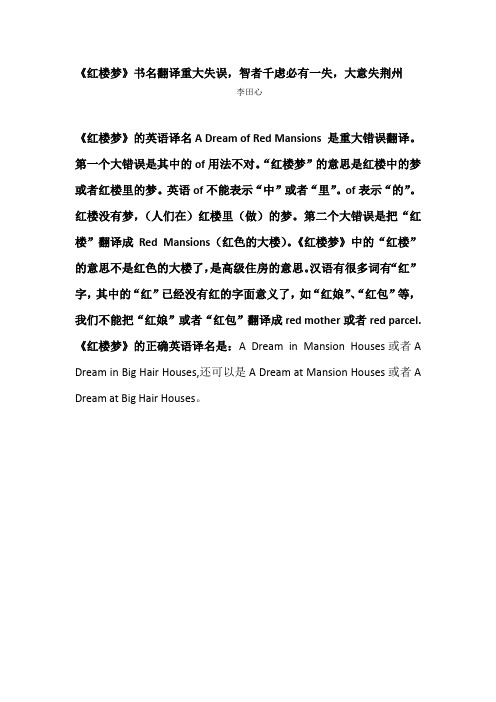
《红楼梦》书名翻译重大失误,智者千虑必有一失,大意失荆州
李田心
《红楼梦》的英语译名A Dream of Red Mansions 是重大错误翻译。
第一个大错误是其中的of用法不对。
“红楼梦”的意思是红楼中的梦或者红楼里的梦。
英语of不能表示“中”或者“里”。
of表示“的”。
红楼没有梦,(人们在)红楼里(做)的梦。
第二个大错误是把“红楼”翻译成Red Mansions(红色的大楼)。
《红楼梦》中的“红楼”的意思不是红色的大楼了,是高级住房的意思。
汉语有很多词有“红”字,其中的“红”已经没有红的字面意义了,如“红娘”、“红包”等,我们不能把“红娘”或者“红包”翻译成red mother或者red parcel. 《红楼梦》的正确英语译名是:A Dream in Mansion Houses或者A Dream in Big Hair Houses,还可以是A Dream at Mansion Houses或者A Dream at Big Hair Houses。
中国古代部分书籍名著的英文译名

中国古代部分书籍名著的英文译名中国古代部分书籍名著的英文译名《本草纲目》 Compendium of Materia Medica《红楼梦》 A Deam in Red Mansions (The Story of the Stone) 《聊斋志异》 Strange Tales of a Lonely Studio《论语》 Analects of Confucius《三国演义》 The Romance of the Three Kingdoms《山海经》 the Classic of Mountains and Rivers / Mountain and Sea Classics《围城》 A Surrounded City《西厢记》 The Romance of West Chamber《西游记》 Pilgrimage to the West; Journey to the West《资治通鉴》 History as a Mirror《水浒传》 Heroes of the Marshes; Water Margins《大学》The Great Learning《中庸》The Doctrine of the Mean《论语》The Analects of Confucius《孟子》The Words of Mencius《诗经》The Book of Songs《书经》The Book of History《易经》The Book of Changes《礼记》The Book of Rites《春秋》The Spring and Autumn Annals《战国策》Stratagems of the Warring States《史记》Records of the Grand Historian《世纪新说》New sayings of the World《西行漫记》Red Star over China|考试大收集整理1.四书 The Four Books2.五经 The Five Classics3.《大学》 The Great Learning4.《中庸》 The Doctrine of the Mean,The Way of Medium5.《论语》The Analects of Confucious,The Confucious Analects6.道德经 The Classic of the Virtue of the Dao,The Book of Lao Zi,Dao De Jing7.《孟子》 The Work of Mencious,Mencious8.《书经/尚书》 The Book of History9.《易经/周易》 The Book of Changes10.《礼记》The Book of Rites,The Book of Social Changes Ceremonies11.《春秋》 The Spring and Autumn Annals12.《史记》 History of Records,Records of the History13.《楚辞》 Poetry of the South14.《左传》 Zuo Commentary(Spring and Autumn of Mr.Lu)15.《孙子兵法》 The Art of War16.《墨子》 Modi17.《非攻》 Condemnation of Offensive War18.《商君书》 The Book of Lord Shang19.《更法》 The Reform of the Law20.《过秦论》 The Faults of Qin21.《完壁归赵》 Return the Jade Intact to the State of Zhao22.《毛遂自荐》 Mao Sui Recommends Himself23.《苏武牧羊》 Su Wu Tends Sheep24.《洛神赋》 The Goddess of the Luo25.《出师表》 Memorial on Going to War。
红楼梦 英译本 对比分析 英汉互译
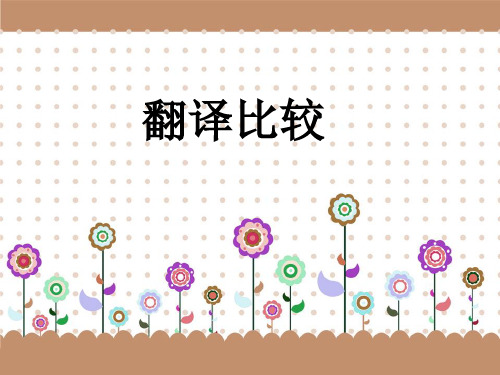
原词:梨香园 Y: Pear Fragrance Court H: Pear Tree Court
杨译:Fragrance的意思是香气 霍译:直接将其译成了梨园 观点:杨的版本比较好,表现出了香,毕竟后来 这作为薛宝钗的住所,霍的版本直接译成梨园, 缺少女孩子的文气。
《红楼梦》两英译本比较之 ——句子
《红楼梦》两英译本比较之 ——文化
原句 薛蟠心中暗喜道:“……可知天从人愿。”
Y: It shows Heaven is kind . H:Fortune is on my side.
杨译:用Heaven表示天。 霍译:直接将这句话用理解的意思表达。
观点:明显这句话是霍的版本比较好。 杨的版本着重于对中国文化的表示,选择了 直译,因此语言的弹性受到了限制,用 Heaven表现天,为了让外国人理解天对中 国古代人民的重要性。 而霍的版本则更注重语言的功能对等。天从 人愿的意思就是自己想的能够实现,就是幸 运,所以他的版本在读起来的时候更为通顺 易懂。
《红楼梦》两英译本比较之 ——称谓
原词:贾母
H:Grandmother Jia Y:The lady Dowager(贵妇、继承亡夫爵位的遗孀) 霍译:考虑到了贾母王夫人和薛蟠的血缘关系
杨译:更加注重老太太在此语境的尊重之意
观点:虽然是简单的称谓也要考虑到深厚的内涵意义,都从某 一角度恰当的表达了文章的含义。
杨译:采用异化的翻译策略,旨在将中国的传统文化介绍给西方读者。
霍译:只用”years“泛化的译了”春秋',采用了规划的翻译策略, 使原文的文化色彩在译文中变得浅淡,这样更利于西方读者的理解 和接受。 观点: 杨译保留了中国的文化信息,霍译在文化信息的传达上有所亏损, 但英语语言的表达更地道。各有千秋,难分伯仲。
【红楼梦】的两个英文译本比较
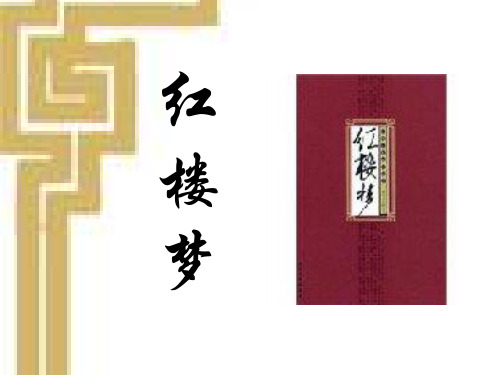
Thank you
解读
• 中文中的“打量”的意思是从 头到脚的上下看,杨宪益夫妇 和霍克斯的译文很好地反映了 这一点。 • 文中熙凤姐“携”着黛玉,携 并非是握着,表达出来的是非 常珍惜,而lead 和conduct也准 确的表达了这一思想。
• “况且这通身的气派,竟不像老祖 宗的外孙女,竟是个嫡亲的孙女,” • “你们趁早打扫两间下房,让他们 去歇歇。” • 杨宪益夫妇译:She doesn’t take after her father, son-in-law of our Old Ancestor, but looks more like a Jia. • Hurry up and clear out a couple of rooms where they can rest. • 霍克斯译:She doesn’t take after your side of the family, Granny. She’s more like a Jia. • You’d better hurry up and get a couple of rooms swept out for them to rest in.
• 一双丹凤三角眼,两弯柳叶吊 梢眉。 • 杨宪益夫妇译:She had the almond-shaped eyes of a phoenix, slanting eyebrows as long and drooping as willow leaves. • 霍克斯译:She had, however, eyes like a painted phoenix, eyebrows like willow-leaves.
解读
• 原文中用了两个“竟”,都是王熙 凤用来夸林黛玉,在夸林黛玉的同 时也是在取悦贾母,这两个译本都 使用了more like来体现这个“竟” 字,可见对原文的把握都是很到位 的,但是第一个“竟”均为体现。 原文中的两句话,第一句话是王熙 凤对林黛玉的夸奖,第二句是对下 人们的吩咐。第一句体现的是关切, 而第二句是主人对仆人的吩咐。这 一点上,杨宪益夫妇的表达更好的 表达了这种口吻,一种上对下的气 势。
24部中国名著书名的英文翻译

24部中国名著书名的英文翻译《西游记》Pilgrimage to the West; Journey to the West《三国演义》The Romance of the Three Kingdoms《红楼梦》A Dream in Red Mansions (The Story of the Stone)《水浒传》 Heroes of the Marshes; Water Margins《本草纲目》 Compendium of Materia Medica《聊斋志异》 Strange Tales of a Lonely Studio《论语》 Analects of Confucius《山海经》the Classic of Mountains and Rivers《围城》 A Surrounded City《西厢记》 The Romance of West Chamber《资治通鉴》 History as a Mirror《史记》 Shi Ji/ Historical Records四书(《大学》、《中庸》、《论语》、《孟子》)The Four Books (The Great Learning, The Doctrine of the Mean,The Analects of Confucius, The Mencius)《阿Q正传》 The True Story of Ah Q《春秋》 Spring and Autumn Annals《论语》THE ANALCETS OF CONFUCIUS《诗经》the book of odes《世说新语》 essays and criticism (shi shuo hsin yu)《封神演义》 the legend of deification《金瓶梅》 The golden lotus《西厢记》 The west chamber。
四大名著英文翻译
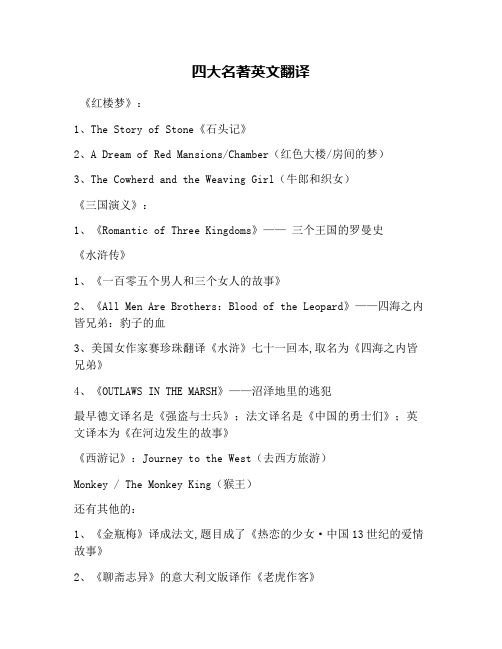
四大名著英文翻译《红楼梦》:1、The Story of Stone《石头记》2、A Dream of Red Mansions/Chamber(红色大楼/房间的梦)3、The Cowherd and the Weaving Girl(牛郎和织女)《三国演义》:1、《Romantic of Three Kingdoms》——三个王国的罗曼史《水浒传》1、《一百零五个男人和三个女人的故事》2、《All Men Are Brothers:Blood of the Leopard》——四海之内皆兄弟:豹子的血3、美国女作家赛珍珠翻译《水浒》七十一回本,取名为《四海之内皆兄弟》4、《OUTLAWS IN THE MARSH》——沼泽地里的逃犯最早德文译名是《强盗与士兵》;法文译名是《中国的勇士们》;英文译本为《在河边发生的故事》《西游记》:Journey to the West(去西方旅游)Monkey / The Monkey King(猴王)还有其他的:1、《金瓶梅》译成法文,题目成了《热恋的少女·中国13世纪的爱情故事》2、《聊斋志异》的意大利文版译作《老虎作客》3、《赵氏孤儿》由法国文学家伏尔泰改写后易名为《中国孤儿》.译作,也有节译的.4、《警世通言》中的《杜十娘怒沉百宝箱》,德莫朗译成《蒙辱的东方女性》,而英文译名则是《名妓》.5 、《聊斋志异》Strange Tales from a Lonely Studio(摄影棚里的寂寞传奇)6、《西厢记》The Western Chamber(向西边窗口)8、《醒世恒言》Stories to Awaken Men(觉醒者的故事)9、《喻世明言》Stories to Enlighten Men(开导者的故事)10、《警世通言》Stories to Warn Men (警告者的故事)11、《官场现形记》Exposure of the Official World(接触官方世界)12、《本草纲目》Outline of Herb Medicine(贺伯固医学概要)奇怪!13、《史记》 Records of the Historian(历史学家的纪录)14.《资治通鉴》History as a Mirror(以史为镜)。
24部中国名著书名的英文翻译
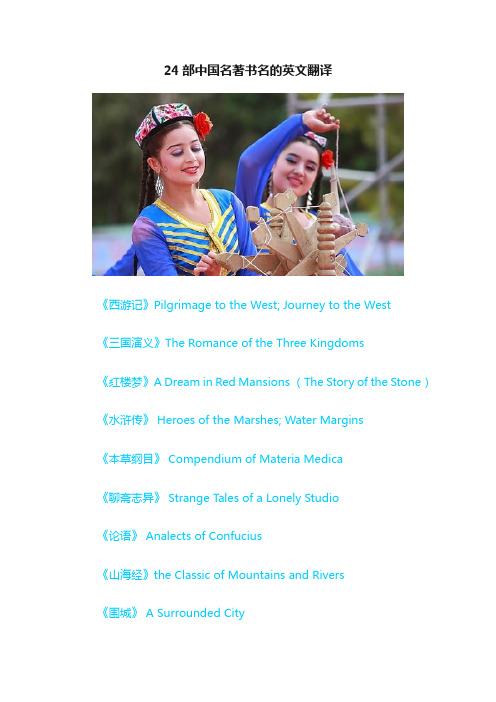
24部中国名著书名的英文翻译《西游记》Pilgrimage to the West; Journey to the West《三国演义》The Romance of the Three Kingdoms《红楼梦》A Dream in Red Mansions (The Story of the Stone)《水浒传》 Heroes of the Marshes; Water Margins《本草纲目》 Compendium of Materia Medica《聊斋志异》 Strange Tales of a Lonely Studio《论语》 Analects of Confucius《山海经》the Classic of Mountains and Rivers《围城》 A Surrounded City《西厢记》 The Romance of West Chamber《资治通鉴》 History as a Mirror《史记》 Shi Ji/ Historical Records四书(《大学》、《中庸》、《论语》、《孟子》)The Four Books (The Great Learning, The Doctrine of the Mean,The Analects of Confucius, The Mencius)《阿Q正传》 The True Story of Ah Q《春秋》 Spring and Autumn Annals《论语》THE ANALCETS OF CONFUCIUS《诗经》the book of odes《世说新语》 essays and criticism (shi shuo hsin yu)《封神演义》 the legend of deification《金瓶梅》 The golden lotus《西厢记》 The west chamber。
中国古代部分书籍名著的英文译名

中国古代部分书籍名著的英文译名《本草纲目》 Compendium of Materia Medica《红楼梦》 A Deam in Red Mansions (The Story of the Stone)《聊斋志异》 Strange T ales of a Lonely Studio《论语》 Analects of Confucius《三国演义》 The Romance of the Three Kingdoms《山海经》 the Classic of Mountains and Rivers / Mountain and Sea Classics 《围城》 A Surrounded City《西厢记》 The Romance of West Chamber《西游记》 Pilgrimage to the West; Journey to the West《资治通鉴》 History as a Mirror《水浒传》 Heroes of the Marshes; Water Margins《大学》The Great Learning《中庸》The Doctrine of the Mean《论语》The Analects of Confucius《孟子》The Words of Mencius《诗经》The Book of Songs《书经》The Book of History《易经》The Book of Changes《礼记》The Book of Rites《春秋》The Spring and Autumn Annals《战国策》Stratagems of the Warring States 《史记》Records of the Grand Historian 《世纪新说》New sayings of the World《西行漫记》Red Star over China。
24部中国古代名著的英文名
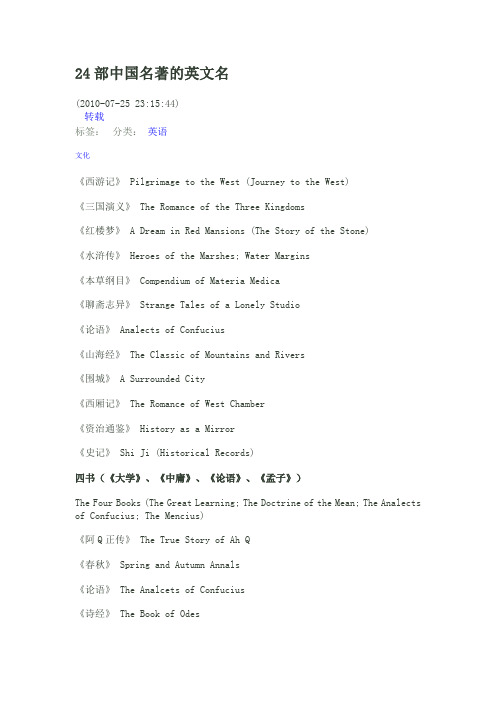
24部中国名著的英文名(2010-07-25 23:15:44)转载分类:英语标签:文化《西游记》 Pilgrimage to the West (Journey to the West)《三国演义》 The Romance of the Three Kingdoms《红楼梦》 A Dream in Red Mansions (The Story of the Stone)《水浒传》 Heroes of the Marshes; Water Margins《本草纲目》 Compendium of Materia Medica《聊斋志异》 Strange Tales of a Lonely Studio《论语》 Analects of Confucius《山海经》 The Classic of Mountains and Rivers《围城》 A Surrounded City《西厢记》 The Romance of West Chamber《资治通鉴》 History as a Mirror《史记》 Shi Ji (Historical Records)四书(《大学》、《中庸》、《论语》、《孟子》)The Four Books (The Great Learning; The Doctrine of the Mean; The Analects of Confucius; The Mencius)《阿Q正传》 The True Story of Ah Q《春秋》 Spring and Autumn Annals《论语》 The Analcets of Confucius《诗经》 The Book of Odes《世说新语》 Essays and Criticism《封神演义》 The Legend of Deification 《金瓶梅》 The Golden Lotus《西厢记》 The West Chamber。
- 1、下载文档前请自行甄别文档内容的完整性,平台不提供额外的编辑、内容补充、找答案等附加服务。
- 2、"仅部分预览"的文档,不可在线预览部分如存在完整性等问题,可反馈申请退款(可完整预览的文档不适用该条件!)。
- 3、如文档侵犯您的权益,请联系客服反馈,我们会尽快为您处理(人工客服工作时间:9:00-18:30)。
直到1973年,《红楼梦》书名误读才得到真正的解决。霍克斯深知“红楼”涵义难以完整地翻译,于是他放弃了“红楼梦”这个名字,而选择曹著的本名“石头记”,译作The Story of the Stone。这个犹如神助的更名避免了硬译“红楼”的困窘,更加贴合西方文化的理解,同时又无损原著的完整,真可谓两全其美!
红楼梦》唯一正确的英文译名 Post By:2010-5-25 19:28:45 [只看该作者]
1973年霍克斯译本的英文名,是目前唯一正确的曹著书名
一些搞同声传译的朋友写信向我求教,希望我能够帮助他们提高笔译方面的功力,并希望我来指导他们的中文阅读。这些朋友非常聪明,他们没有把文化传播简单地理解为翻译技巧。一般来讲,提高对外传播的质量往往需要大视野和大智慧。
举一个典型的例子,《红楼梦》的书名在其170多年的英文翻译历史中曾出现九种译法,但大多译为Dream of the Red Chamber(红色阁楼之梦),以及A Dream of Red Mansions(红色宅院之梦)。九大英文译本中,唯独霍克斯将其定名为The Story of the Stone(石头记),笔者认为只有他翻译正确。众多译者都把“红楼”拆开,逐字翻译,掉进了误读的陷阱。其实,国内很多人对“红楼”也存在误解。
《红楼梦》书名的翻译给我们一个重要启示——对待翻译和传播,既不能轻视,更不要悲观。
中西文化之间的确存在不可译的“硬骨头”,但这些“硬骨头”并不妨碍对外文化传播,霍克斯成功突破书名瓶颈就是积极的个案。对外传播,需要大视野,也需要大智慧。这不能只是翻译领域的课题,也不应是个人的事业,而应该成为一项国策,成为多学科参与的富有创造力的系统工程。
《红楼梦》170多年的英文翻译史,有9个译文版本
“红楼”一词有三个子涵义:其一,泛指装饰奢华的楼房,如“红楼归晚,看足柳昏花暝”(宋代史达祖《双双燕》),“人散曲终红楼静,半墙残月摇花影”(清代洪升《长生殿·偷曲》);其二,指富贵人家女子的闺房,如“花外红楼,当时青鬓颜如玉。”(宋代王庭《点绛唇》);其三,意同“青楼”,即娼妓的住所,如“二卿有此才貌,误落风尘,翠馆红楼,终非结局,竹篱茅舍,及早抽身。”(清朝周友良《珠江梅柳记》卷二)“红楼”并非“朱楼”,后者意指“华美的楼阁”,只和“红楼”的一个子涵义相符。“红楼”一词涵义丰富,表意很虚,因此只可意会,不可言传,切忌将其单一化理解,同时切忌作具体化说明。
曹著采用“红楼”一词,涵盖了“红楼”的三个涵义,指荣宁二府(涵义一)、潇湘馆(涵义二)和娼馆(贾府败落之后,巧姐、史湘云、妙玉等一干女儿沦落风尘),符合全书万艳同悲、世事无常的悲剧幻灭的基调。所以,“红楼”绝不能分拆为从一个狭义的角度描述“红楼”,没能传达“红楼”的完整内涵,均属误读。这个错误影响了英语世界100多年,而我们中国学界对此不闻不问,狭隘封闭,情何以堪!
